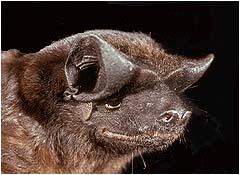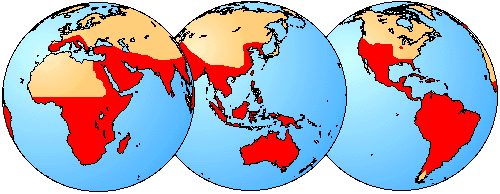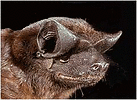Molossidae
Free-tailed Bats
Nancy B. Simmons and Tenley Conway- Tomopeatinae
- Molossinae
Introduction
Molossidae (including Tomopeatinae) is a diverse group of fast-flying aerial insectivores. Some species live in very large colonies that can exceed 5 million individuals. Molossidae currently includes over 13 genera and 80 species (Koopman, 1993; Sudman et al., 1994). Two clades are currently recognized within Molossidae: Tomopeatinae and Molossinae (Sudman et al., 1994; Simmons, 1998; Simmons and Geisler,1998). Tomopeatinae is monotypic, containing only Tomopeas ravus, a species found only in Peru. All other molossids belong to Molossinae.
Characteristics
All Molossidae have the following features:
- no connection between m. sternohyoideus and basihyal.
- m. ceratohyoideus insterts at least part onto stylohyal.
- seventh cervial vertebra and first thoratic vertebra at least partially fused.
- length of manubrium posterior to lateral process >2.5 times the transverse width.
- distal acromion process with triangular posterolateral projection.
- coracoid process curves ventromedially.
- head of hymerus oval or elliptical.
- ischium with large ischial tuberosity that projects dorsally from posterior horizontal ramus.
Discussion of Phylogenetic Relationships
Prior to 1994, Tomopeatinae was considered to be a subfamily of Vespertilionidae, but Sudman et al. (1994) and Simmons (1998) demonstrated that Tomopeas is more closely related to molossids than to vespertilionids. Monophyly of Molossidae (including Tomopeatinae) is stongly supported by morphological data (Simmons, 1998; Simmons and Geisler, 1998).
Phylogenetic relationships within Molossidae have been investigated using morphometrics (Freeman, 1981), discrete morphological characters (Legendre, 1984, 1985; Hand, 1990), allozymes (Sudman et al., 1994), and cytochrome b gene sequences (Sudman et al., 1994). Trees and classifications derived from these studies are largely incongruent, but most agree that Molossinae is monophyletic.
References
Barkley, L. J. 1984. Evolutionary relationships and natural history of Tomopeas ravus (Mammalia: Chiroptera). Masters thesis, Lousiana States University, Baton Rouge, Louisiana.
Freeman, P. W. 1981. A multivariate study of the family Molossidae (Mammalia, Chiroptera): morphology, ecology, evolution. Fieldiana Zoology, 7: 173 pp.
Hand, S. J. First tertiary molossid (Microchiroptera: Molossidae) from Australia: its phylogenetic and biogeographic implications. Mem. Queensland. Museum, 28:175-192.
Hill, J.E., and J.D. Smith. 1984. Bats: a natural history. Austin: University of Texas Press.
Koopman, K. F. 1983. Order Chiroptera. In Mammal species of the world, a taxonomic and geographic reference, 2nd ed. D. E. Wilson and D. M. Reeder. Washinton, D. C.: Smithsonian Institution Press.
Legendre, S. 1984. Etude odontologique des representants actuels du group Tadarida (Chiroptera, Molossidae). Implications phylogenetques, systematiques et zoogeographiques. Revue de Suisse Zoology, 91:99-442.
Legendre, S. 1985. Molossides (Mammalia, Chiroptera) cenezoiques de l'Ancien et du Nouveau Monde; statut systematique; integration phylogenique des donnees. N. Jahrb. Geol. Palaont. Abh., 170: 205-227.
Simmons, N. B. 1998. A reappraisal of interfamilial relationships of bats. In Bats: Phylogeny, Morphology, Echolocation and Conservation Biology. T.H. Kunz and P.A. Racey (eds.). Washington: Smithsonian Institution Press.
Simmons, N. B. & J. H. Geisler. 1998. Phylogenetic relationships of Icaronycteris, Archeonycteris, Hassianycteris, and Palaeochiropteryx to extant bat lineages, with comments on the evolution of echolocation and foraging strategies in microchiroptera. Bulletin of the American Museum of Natural History. 235:1-182.
Sudman, P. D., L. J. Barkley, and M. S. Hafer, 1994. Familial affinity of Tompoeas ravus (Chiroptera) based on protein electophoretic and cytochrome B sequence data. Journal of Mammalogy 75:365-377.
Title Illustrations

| Scientific Name | Molossus molossus |
|---|---|
| Image Use |
 This media file is licensed under the Creative Commons Attribution-NonCommercial License - Version 3.0. This media file is licensed under the Creative Commons Attribution-NonCommercial License - Version 3.0.
|
| Copyright |
© 1998 Nancy B. Simmons

|
About This Page
Nancy B. Simmons

American Musuem of Natural History, New York, New York, USA
Tenley Conway

University of Toronto at Mississauga, Ontario, Canada
Correspondence regarding this page should be directed to Nancy B. Simmons at
Page copyright © 1997 Nancy B. Simmons
 Page: Tree of Life
Molossidae. Free-tailed Bats.
Authored by
Nancy B. Simmons and Tenley Conway.
The TEXT of this page is licensed under the
Creative Commons Attribution License - Version 3.0. Note that images and other media
featured on this page are each governed by their own license, and they may or may not be available
for reuse. Click on an image or a media link to access the media data window, which provides the
relevant licensing information. For the general terms and conditions of ToL material reuse and
redistribution, please see the Tree of Life Copyright
Policies.
Page: Tree of Life
Molossidae. Free-tailed Bats.
Authored by
Nancy B. Simmons and Tenley Conway.
The TEXT of this page is licensed under the
Creative Commons Attribution License - Version 3.0. Note that images and other media
featured on this page are each governed by their own license, and they may or may not be available
for reuse. Click on an image or a media link to access the media data window, which provides the
relevant licensing information. For the general terms and conditions of ToL material reuse and
redistribution, please see the Tree of Life Copyright
Policies.
Citing this page:
Simmons, Nancy B. and Tenley Conway. 1997. Molossidae. Free-tailed Bats. Version 01 January 1997 (under construction). http://tolweb.org/Molossidae/16103/1997.01.01 in The Tree of Life Web Project, http://tolweb.org/











 Go to quick links
Go to quick search
Go to navigation for this section of the ToL site
Go to detailed links for the ToL site
Go to quick links
Go to quick search
Go to navigation for this section of the ToL site
Go to detailed links for the ToL site